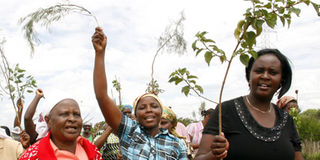Human-wildlife conflict on the rise in Narok

Women protest the invasion of their farms by wild animals. Narok County is one of the human-wildlife conflict (HWC) hotspots in the country with elephants identified as the most problematic wildlife species. PHOTO/SULEIMAN MBATIAH
What you need to know:
- The conflict has been attributed to activities such as crop farming, charcoal burning and human settlements.
- Narok County is currently designated as one of the human-wildlife conflict (HWC) hotspots in the country with elephants identified as the most problematic wildlife species.
- About 200 elephants have been cut off from the greater Mara ecosystem and are currently considered a sub-population of the Mara.
- The county governor have stopped all land transaction in the county until a county land development plan, including curving out wildlife corridors, is complete.
Human-wildlife conflict in Narok County has been aggravated by rapid change in the lifestyle of local communities from pastoralism to crop farming and other incompatible land-use practices.
According to the Kenya Wildlife Service, such conflict in areas surrounding the Maasai Mara Game Reserve is mainly attributed to increased human population and loss of wildlife habitat due to uncontrolled human activities, especially crop farming, charcoal burning and human settlements.
KWS Assistant Director Central Rift conservation area Mr George Nagwala said Narok County is currently designated as one of the human-wildlife conflict (HWC) hotspots in the country with elephants identified as the most problematic wildlife species.
Speaking during the launch of the five-day wildlife census in the Mara and Serengeti ecosystems, Mr Nagwala said KWS Narok station indicates that out of the 9,299 human wildlife conflict cases reported in the last 10 years, 5,052 (54 per cent) were attributed to elephants.
The latest case was reported a week ago when an 88-year-old man was trampled by an elephant in Siana Conservancy near Maasai Mara Game Reserve.
LONG-TERM MONITORING
KWS further indicated that long-term monitoring of elephant movements in the affected area through satellite tracking has established that about 200 elephants have been cut off from the greater Mara ecosystem and are currently considered a sub-population of the Mara.
“Reports from the common impacts of human elephant conflict include human deaths, human injuries, crop destruction, human threats/obstruction, other property destruction,” said Mr Nagwala.
Two days ago, Kenya and Tanzania embarked on a joint wildlife census in Maasai Mara Game Reserve and the Serengeti National Park to establish the landscape’s wildlife population, trends and distribution.
MAP DISPERSAL AREAS
The move is aimed at mapping out dispersal areas and migratory corridors to know wildlife areas, where they go, which areas are important, and ascertain reduction in numbers due to increased poaching in the last two years.
Narok County executive for trade Tourism and Wildlife Allan Ole Twala said increased human wildlife conflict is occasioned by the human influence on the ecosystem, through demarcation of traditional wildlife areas and blocking of migratory routes.
“There is a big concern for the future of wildlife in Narok and especially the Maasai Mara, and the census will give us a direction on what should be done to increase wildlife numbers and preserve their habitats,” said Mr Twala.
He said the county governor have stopped all land transaction in the county until a county land development plan, including curving out wildlife corridors, is complete.





